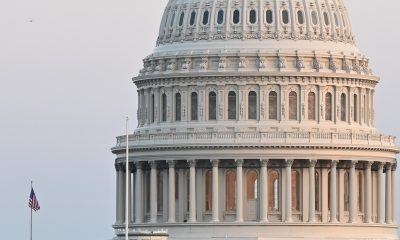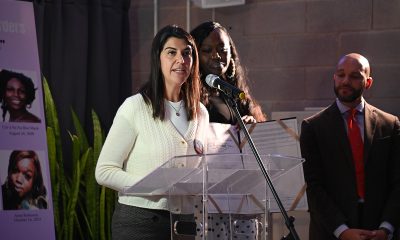a&e features
New Museum of the Bible offers no mention of LGBT issues and scripture
Curators claim material is for visitors to interpret; gay Christians say it could have been much worse
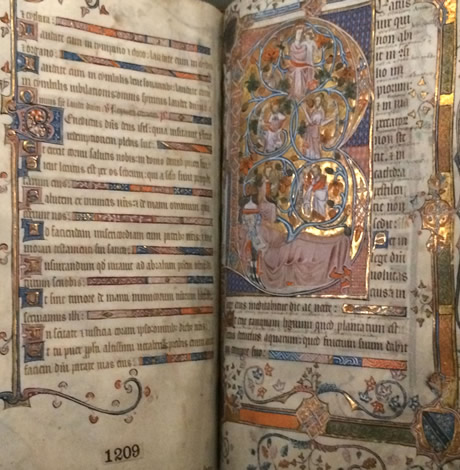
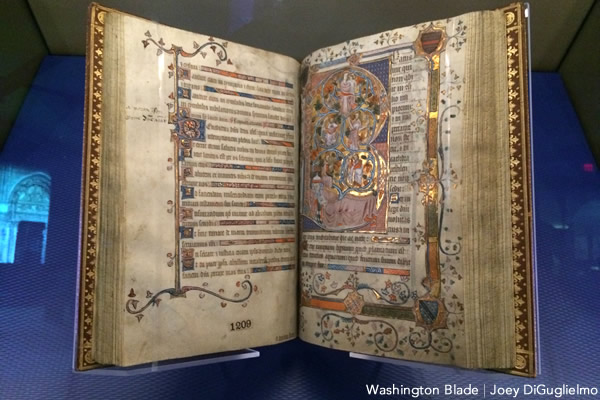
One of many historical Bibles displayed at the new Museum of the Bible in Washington. (Washington Blade photo by Joey DiGuglielmo)
Museum of the Bible
400 4th St., S.W.
Free admission
The team behind the new Museum of the Bible, which opened last weekend in Washington, said all along they wouldn’t “mention homosexuality, abortion or any other political commentary” and they’ve stayed true to their word.
The controversial museum — housed in a massive, 430,000-square-foot building three blocks from the U.S. Capitol in Southwest Washington — was established as a 501(c)(3) nonprofit in 2010. In 2012, museum personnel purchased the former Washington Design Center for $50 million and spent years having it converted into an eight-story structure with two basement levels and two new floors added to the existing rooftop at a total cost of more than $500 million.
All the effort and expense shows. This is no amateur endeavor despite the bumps in the road the billionaires behind it — it’s been largely funded by the Green family, owners of Hobby Lobby — have encountered along the way.
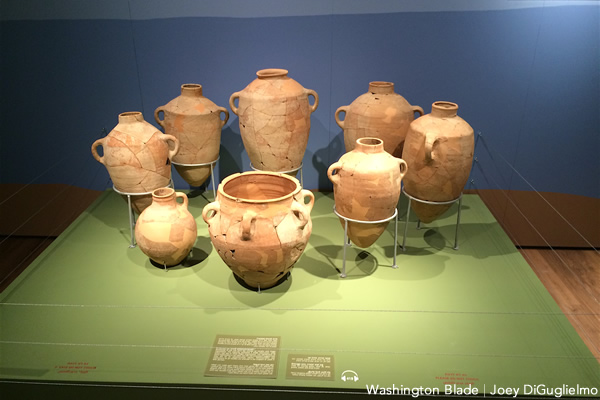
Pottery vessels on display at Museum of the Bible discovered at the Khirbet Qeiyafa, the site of an ancient fortress city overlooking the Elah Valley. Ruins of the fortress were discovered in 2007 about 20 miles from Jerusalem. (Washington Blade photo by Joey DiGuglielmo)
During a media preview last week, a few finishing touches were still being applied. Ladders and cans of paint were seen in several corridors much like they were during media previews for the National Museum of African-American History and Culture that opened last year. The museum’s communications team didn’t hesitate in including the Blade. The Blade has also learned of at least one openly LGBT person on staff at the museum.
Steve Green is president of Hobby Lobby and chair of the Museum of the Bible board. He told media at the museum on Nov. 15 that the purpose of the museum was “not about us espousing our faith.”
“The example I primarily use is in the Bible, it says, ‘In the beginning God created …,’ so we tell that story on the narrative floor but it’s not our position to tell you when God created, so we don’t take a position on whether that’s true or not. We just say, ‘Here’s the Bible story,’ and then you can decide what you do with it.”
Another recurring theme from staff is that the museum is “non-sectarian” and they’ve gone to great lengths to take an ecumenical approach. One exhibit features items on loan from the Vatican and the museum boasts what it claims is the world’s largest private collection of retired Torah scrolls and the second-largest private collection of Dead Sea Scroll fragments, the earliest-surviving manuscripts of the Hebrew Bible.
“Obviously we’re trying to be inclusive,” Green said. “We have the Israel Antiquity Authority, we have the Vatican having space in here, so it’s not about a faith tradition. We have a love for the Bible and we want to include everyone. We want atheists to feel comfortable coming in here because they’ll know, in essence, we’re not pushing our agenda. We’re just trying to educate them on a book. If you wanna believe this book is a novel, fine. Just be educated on what you believe and that’s what we wanna do.”
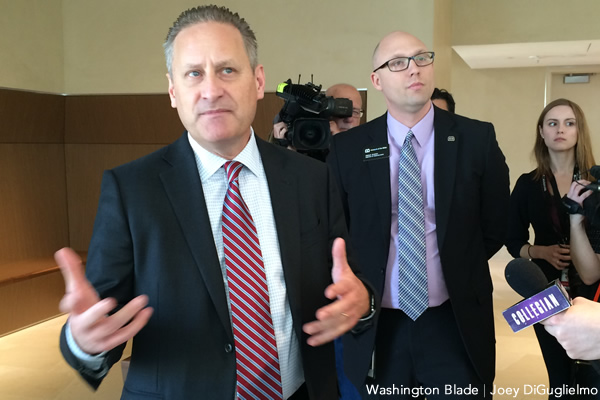
Steve Green, chairman of the Museum of the Bible board and president of Hobby Lobby, speaks to reporters at the museum on Nov. 15. (Washington Blade photo by Joey DiGuglielmo)
The scope alone is impressive. Museum personnel claim to read every placard, see every artifact and experience every activity in the museum, it would take nine days at eight hours per day.
And while some have expressed relief that the museum has taken a vastly more academic approach than, say, the Creation Museum in Petersburg, Ky., which presents the Genesis account of creation as literally true, the Museum of the Bible is still wildly controversial.
The museum has come under intense criticism — the Washington Post’s coverage has been especially tough — for several issues. Among them are:
• what some consider the Green family’s baggage from their 2014 fight against mandatory employer-provided birth control that resulted in a Supreme Court ruling that struck down the contraceptive mandate part of the Affordable Care Act requiring employers to cover certain contraceptives for female employees. The Greens have paid for newspaper ads espousing the “real meaning” of Christmas and have donated $70 million to Oral Roberts University and other evangelical institutions that lean toward the fundamentalist end of the religious spectrum according to Vox and other outlets.
• a $3 million fine imposed by the Department of Justice in a civil action suit that said the Greens, who started collecting in 2009, had obtained thousands of Iraqi artifacts they obtained without the necessary clearances in 2010 and 2011. The Greens said the seized artifacts were never part of the museum collection and said they’ve “engaged the leading experts in abiding the highest standards of museum guidelines (from the Association of Art Museum Directors) and other organizations. Those are the policies that we will adhere to here at the museum,” Green said last week.
• accusations that Hobby Lobby owners neglected to do their due diligence in acquiring the artifacts that got them in trouble. At the time, they said, “the company was new to the world of acquiring these items and did not fully appreciate the complexities of the acquisitions process. This resulted in some regrettable mistakes. The company imprudently relied on dealers and shippers who, in hindsight, did not understand the correct way to document and ship these items.” According to museum tax records cited by the Washington Post, Hobby Lobby donated about $201 million in artifacts to the museum, about 2,800 of the Greens’ 40,000-piece collection.
• a sense that the museum’s mission has shifted from inception to fruition. Perhaps, some would argue, for the better, yet it casts doubts on the owners’ intentions. According to Vox, in 2011, the museum’s nonprofit tax filings stated its purpose was “to bring to life the living Word of God, to tell its compelling story of preservation and to inspire confidence in the absolute authority and reliability of the Bible.” By 2013, the wording said simply that “we exist to invite all people to engage with the Bible.” “It felt in the last few years like they were moving from running in the primary to running in the general election,” says Matthew Vines, a prominent gay evangelical writer. “Now you’re going to focus on reaching the center and not just activating the base anymore. Now it feels more like a normal, general-election campaign.”
• the role of the National Christian Foundation, a Georgia-based organization with a mission to “advance God’s kingdom,” that has given millions of dollars annually to churches and civic groups, many of which, according to the Washington Post, are “engaged in court fights against same-sex marriage, abortion rights and other social policies.” The foundation directed about $163 million to the museum between 2013-2015 according to the Post, which cited tax returns for its information. While the museum touts that 50,000 donors have given money to the museum, which does not charge admission and is registered as a public charity, 89 percent of 2016 donations came from the National Christian Foundation; it was 96 percent in 2015, Museum President Cary Summers confirmed to the Post.
• several claims of dubious action made by Candida R. Moss, a theology professor at the University of Birmingham, and Joel S. Baden, a professor of Hebrew Bible at Yale Divinity School, in their new book “Bible Nation: the United States of Hobby Lobby” in which, according to the Post, they claim the Greens have “exploited tax-exempt rules to financially benefit from their acquisitions” and “have probably purchased forgeries, items of questionable provenance and possibly even looted antiquities.” The book also claims the Green Scholars Initiative has hired a disproportionate number of scholars with similar evangelical backgrounds and that while they maintain the Greens are well-intentioned, they accuse them of dumbing down on biblical scholarship. That they “believe it is possible to tell the story of the Bible without interpretation betrays not only their Protestant roots and bias,” the authors write, “but also their fundamentally anti-intellectual orientation.”
It’s a concern echoed by some LGBT believers as well. Because the museum just opened and few have had a chance to experience it directly, some were hesitant to say much although concerns were expressed.
Fred Davie, vice president of Union Theological Seminary, said the Bible is not a simple book.
“The way these ancient texts have been put together and then blessed by various religious bodies is very, very complicated,” Davie, who’s gay, said. “We have to be careful because most believers’ understanding of scripture in my experience is pretty much at a very basic, almost Sunday school level. … The Bible as we know it has been used to do lots of bad things to God’s creation, both creatures and flora and fauna throughout history — everything from enslaving people to denigrating women and relegating them to a lesser roles to all forms of oppression against LGBT folks.”
Davie said he’s been encouraged by media accounts he’s read that state the museum staff has attempted to be non-partisan and ecumenical, but also said the whole concept of a museum such as this could be problematic.
“You want to try to give them credit for making scripture accessible to large numbers of people and to make it popular … but it is very complex and to attempt to present the museum as an amusement is fraught with pitfalls. If they have tried to be balanced, you know, God bless them, but what I worry about is that it will simply reinforce a Sunday school, simplistic notion of scripture.”
Davie says faulty and overly simplistic interpretations of scripture historically have been used to marginalize many such as African Americans, women and gays. To approach the museum as a vehicle for entertainment, he says, could backfire with similar consequences.
Despite the curators’ claims that they aren’t getting into controversial issues such as homosexuality and abortion, the museum doesn’t tiptoe around all controversy. The second floor is devoted to the “impact of the Bible” and the “Bible in America” and goes from the book’s role in the formation of the United States culminating with “Civil Rights and beyond: equality and religious freedom.”
So why did curators delve into the issue of the Civil Rights Movement but avoid LGBT rights? The museum has exhibits devoted to topics one might not expect such as the Bible in fashion, the Bible in pop culture and others.
Seth Pollinger, director of museum content, said deciding what to include and what to leave out is an ongoing challenge for any museum, especially a new one. His role is to work as a liaison between the designers and scholars and curators. He said the team worked hard to assemble content that is “authentic and sincere and on track with reliability and constructive to the overall message of how everything fits together.”
As for possible LGBT issues in the future, Pollinger said, “I think we’re working on it.”
“I think these are the kinds of discussions that we hope to have and areas we hope to grow in in the future,” he said.
Was there a sense that some topics such as LGBT rights and the Bible might be easier to avoid because they’re so divisive? Pollinger said yes and cites how the Bible historically was used both to justify and condemn slavery, though no pro-slavery items or exhibits are in the museum.
“That was one example where we had to weigh whether or not we could do that from a social standpoint and present those things without doing something that would be offensive,” he said.
He also said that even with eight floors and 430,000 square feet, space is always an issue.
“You want to make sure you’re able to cover a wide spectrum of views and in some cases we felt like we had a very small amount of real estate available,” Pollinger said. “In the future, as we start to feature a balance of views within a small space, we can have more dialogue on that. We just felt that for opening day, we just didn’t have that all solved yet.”
Matthew Solari of BRC Imagination Arts worked on two animated films shown at the museum, one on the Old Testament, another on the New. He’s worked on similar projects for other major museums such as the Kennedy Space Center, the Epcot pavilions and more.
“When we were deciding whether this was something we wanted to throw our energies and talents into, we had several escape hatches at various points along the way where we could have gone the other direction and left,” Solari said. “But we never did. We never felt pressured in any way to say or do something we felt was betraying the promises that were made to us as storytellers in the beginning and also what we thought were going to be stories that were going to be welcoming and kind to people as opposed to people that were going to be finger wagging and thou shalt not. We weren’t interested in doing any of that kind of stuff and we were given a very wide berth. They were an excellent client to work with.”
Vines, founder of the Reformation Project, an agency that works to advance LGBT inclusion in the church, who came to prominence with the 2014 publication of his book “God and the Gay Christian: the Biblical Case in Support of Same-Sex Relationships,” said he’s “cautiously optimistic” about the Museum of the Bible.
He points to recent events in the evangelical world in which World Vision, a “sponsor-a-child” program, backtracked quickly when about 10,000 evangelicals threatened to pull their child sponsorships if the organization opened its doors to hiring gay staff, and InterVarsity Christian Fellowship, a college campus ministry, which took a renewed and harder stance against LGBT-affirming staff last fall.
“Culturally these groups are very similarly situated in terms of their support bases and … I find it encouraging that the Museum of the Bible did not feel compelled to do something similar. I could easily see a number of donors wanting to put strings on their donations and say there had to be one part of the museum that said marriage was one man, one woman for life,” Vines said. “I don’t know the politics and dynamics of those conversations but clearly that didn’t end up happening and I just appreciate, not even knowing all the back story, that the museum is not taking an oppositional position. That is a kind of progress.”

The entrance to Museum of the Bible on 4th Street in Southwest Washington. (Washington Blade photo by Joey DiGuglielmo)
a&e features
Queer highlights of the 2026 Critics Choice Awards: Aunt Gladys, that ‘Heated Rivalry’ shoutout and more
Amy Madigan’s win in the supporting actress category puts her in serious contention to win the Oscar for ‘Weapons’

From Chelsea Handler shouting out Heated Rivalry in her opening monologue to Amy Madigan proving that horror performances can (and should) be taken seriously, the Critics Choice Awards provided plenty of iconic moments for queer movie fans to celebrate on the long road to Oscar night.
Handler kicked off the ceremony by recapping the biggest moments in pop culture last year, from Wicked: For Good to Sinners. She also made room to joke about the surprise hit TV sensation on everyone’s minds: “Shoutout to Heated Rivalry. Everyone loves it! Gay men love it, women love it, straight men who say they aren’t gay but work out at Equinox love it!”
The back-to-back wins for Jacob Elordi in Frankenstein and Amy Madigan in Weapons are notable, given the horror bias that awards voters typically have. Aunt Gladys instantly became a pop culture phenomenon within the LGBTQ+ community when Zach Cregger’s hit horror comedy released in August, but the thought that Madigan could be a serious awards contender for such a fun, out-there performance seemed improbable to most months ago. Now, considering the sheer amount of critics’ attention she’s received over the past month, there’s no denying she’s in the running for the Oscar.
“I really wasn’t expecting all of this because I thought people would like the movie, and I thought people would dig Gladys, but you love Gladys! I mean, it’s crazy,” Madigan said during her acceptance speech. “I get [sent] makeup tutorials and paintings. I even got one weird thing about how she’s a sex icon also, which I didn’t go too deep into that one.”
Over on the TV side, Rhea Seehorn won in the incredibly competitive best actress in a drama series category for her acclaimed performance as Carol in Pluribus, beating out the likes of Emmy winner Britt Lower for Severance, Carrie Coon for The White Lotus, and Bella Ramsey for The Last of Us. Pluribus, which was created by Breaking Bad’s showrunner Vince Gilligan, has been celebrated by audiences for its rich exploration of queer trauma and conversion therapy.
Jean Smart was Hack’s only win of the night, as Hannah Einbinder couldn’t repeat her Emmy victory in the supporting actress in a comedy series category against Janelle James, who nabbed a trophy for Abbott Elementary. Hacks lost the best comedy series award to The Studio, as it did at the Emmys in September. And in the limited series category, Erin Doherty repeated her Emmy success in supporting actress, joining in yet another Adolescence awards sweep.
As Oscar fans speculate on what these Critics Choice wins mean for future ceremonies, we have next week’s Golden Globes ceremony to look forward to on Jan. 11.
a&e features
Looking back at the 10 biggest A&E stories of 2025
‘Wicked,’ Lady Gaga’s new era, ‘Sexy’ Bailey and more

Although 2025 was a year marked by countless attacks on trans rights and political setbacks, the year also saw brilliant queer artists continuing to create art. From Cannes and Sundance Award winners now vying for Oscar consideration to pop icons entering new stages of their careers, queer people persevered to tell their stories through different media.
With the state of the world so uncertain, perhaps there’s no more vital time to celebrate our wins, as seen through some of this year’s top pop culture moments. While there’s no collection of 10 stories that fully encompass “the most important” news, here are some events that got the gays going:
10. ‘Mysterious Gaze of the Flamingo’ wins big at Cannes

The Cannes Film Festival has become a crucial start for films hoping to make their way to the Oscars, and first-time director Diego Céspedes won the top Un Certain Regard prize for his intimate western “The Mysterious Gaze of the Flamingo.” The film is set in the ‘80s and is intended as an allegory for the AIDS epidemic. Seeing a film that unpacks vital queer history win one of the most coveted awards at Cannes has been a huge point of pride in the independent filmmaking community.
Since the film bowed at Cannes, it has been selected as Chile’s Oscar entry in the Best International Feature race. Speaking with The Blade during the film’s AFI Fest run in October, Céspedes said: At first, I was kind of scared to have this campaign position in the times that we’re living [in] here. But at the same time, I think the Oscars mean a huge platform — a huge platform for art and politics.”
9. ‘The Last of Us’ returns for an even gayer season 2
While the first season of The Last of Us gave us one of TV’s most heartbreaking queer love stories in the episode “Long, Long Time,” Season 2 doubled down on its commitment to queer storytelling with the blossoming relationship between Ellie (Bella Ramsey) and Dina (Isabela Merced). The show expanded on the pair’s relationship in the original video game, making it perhaps the central dynamic to the entire season. That unfortunately came with more homophobic backlash on the internet, but those who checked out all the episodes saw a tender relationship form amid the show’s post-apocalyptic, often violent backdrop. For their performance, Ramsey was once again nominated for an Emmy, but Merced deserved just as much awards attention.
8. ‘Emilia Pérez’ sparks controversy
Jacques Audiard’s genre-bending trans musical “Emilia Pérez” proved to be an awards season juggernaut this time last year, winning the Golden Globe for Best Musical/Comedy. But when the lead star Karla Sofia Gascón’s racist, sexist, and homophobic old tweets resurfaced, the film’s Oscar campaign became a tough sell, especially after Netflix had tried so hard to sell Emilia Pérez as the “progressive” film to vote for. Mind you, the film had already received significant backlash from LGBTQ+ audiences and the Mexican community for its stereotypical and reductive portrayals, but the Gascón controversy made what was originally just social media backlash impossible to ignore. The only person who seemed to come out of the whole debacle unscathed was Zoe Saldaña, who won the Oscar for Best Supporting Actress over Ariana Grande.
7. ‘Sorry, Baby’ establishes Eva Victor as major talent
Back in January at the Sundance Film Festival, Eva Victor (known by many for her brand of sketch comedy) premiered their directorial debut “Sorry, Baby” to rave reviews, even winning the Waldo Salt Screening Award. Victor shadowed Jane Schoenbrun on the set of “I Saw the TV Glow,” and seeing Victor come into their own and establish such a strong voice immediately made them one of independent cinema’s most exciting new voices. A memorable scene in the film sees the main character, Agnes (played by Victor), struggling to check a box for male or female, just one example of how naturally queerness is woven into the fabric of the story.
Most recently, Victor was nominated for a Golden Globe for her performance in the film, and she’s represented in a category alongside Jennifer Lawrence (“Die My Love”), Jessie Buckley (“Hamnet”), Julia Roberts (“After the Hunt”), Renate Reinsve (“Sentimental Value”) and Tessa Thompson (“Hedda”). The film also received four Independent Spirit Award nominations overall.
6. Paul Reubens comes out in posthumous doc

While Paul Reubens never publicly came out as gay before passing away in 2023, the two-part documentary “Pee-wee as Himself” premiered back in May on HBO Max, giving the legendary comedian a chance to posthumously open up to the world. Directed by Matt Wolf, the documentary explores how Reubens found his alter ego Pee-Wee Herman and why he kept his private life private.
The documentary won an Emmy in the Outstanding Documentary or Nonfiction Special category and remains one of the most critically acclaimed titles of the year with a 100% Rotten Tomatoes score. Also worth noting, the National Geographic documentary Sally told the posthumous coming out story of Sally Ride through the help of her long-time partner, Tam O’Shaughnessy.
5. Lady Gaga releases ‘Mayhem’
Lady Gaga entered a new phase of her musical career with the release of Mayhem, her seventh album to date. From the frenzy-inducing pop hit Abracadabra to the memorable Bruno Mars duet featured on “Die With a Smile,” seeing Gaga return to her roots and make an album for the most die-hard of fans was especially rewarding after the underwhelming film releases of “House of Gucci” and “Joker: Folie à Deux.” Gaga has been touring with The Mayhem Ball since July, her first arena tour since 2018. She even extended her tour into 2026 with more North American dates, so the party isn’t stopping anytime soon. And Gaga is even set to make an appearance next May in “The Devil Wears Prada 2.”
4. Cynthia Erivo, Ariana Grande perform at the Oscars

While “Wicked: For Good” didn’t quite reach the heights of the first film, we will forever have Cynthia Erivo and Ariana Grande’s breathtaking live performance that opened the 97th Academy Awards. The pair sang a rendition of “Over the Rainbow,” “Home,” and “Defying Gravity,” paying proper homage to the original 1939 “Wizard of Oz.” Even non-Wicked fans can’t deny how magical and brilliantly staged this performance was. With both Erivo and Grande up for acting Oscars last year, they’re hoping to repeat success and make history with consecutive nominations. Either way, let’s hope there’s another live performance in the making, especially with two new original songs (The Girl in the Bubble and No Place Like Home) in the mix.
3. Indya Moore speaks out against Ryan Murphy
Indya Moore has consistently used social media as a platform for activism, and in September, posted a 30-minute Instagram live speaking out against “Pose” co-creator Ryan Murphy. Moore claimed that Murphy wasn’t being a true activist for trans people. “Ryan Murphy, we need you to do more. You need to address the racism, the violence, and the targeting of people on your productions, Ryan Murphy. You do need to make sure trans people are paid equally. Yes, Janet did the right thing,” Moore said. Murphy was also back in the headlines this year for the critically panned “All’s Fair” and the controversial “Monster: The Ed Gein Story” starring Laurie Metcalf and Charlie Hunnam.
2. Cole Escola wins Tony for Best Leading Actor
Few pop culture moments this year brought us together more than Cole Escola winning a Tony award for “Oh, Mary!” the Broadway show they created, wrote and starred in (we love a triple threat!) Escola made history by becoming the first nonbinary person to win a Tony in the leading actor category, and seeing them excitedly rush to the stage wearing a Bernadette Peters-inspired gown instantly became a viral social media moment.
The cherry on top of Escola’s major moment is the recent news that they are writing a Miss Piggy movie with Jennifer Lawrence and Emma Stone producing — news that also broke the internet for the better. We cannot wait!
1. Jonathan Bailey makes gay history as ‘Sexiest Man Alive’

The same year as his on-screen roles in blockbusters “Jurassic World Rebirth” and “Wicked: For Good,” Jonathan Bailey made history as the first openly gay man to be named People magazine’s “Sexiest Man Alive.” The fact that it took 40 years for an openly gay man to earn the title is a signifier of how far we still have to go with queer representation, and seeing Bailey celebrated is just one small step in the right direction.
“There’s so many people that want to do brilliant stuff who feel like they can’t,” he told PEOPLE, “and I know the LGBT sector is under immense threat at the moment. So it’s been amazing to meet people who have the expertise and see potential that I could have only dreamed of.” In 2024, Bailey founded the charity titled The Shameless Fund, which raises money for LGBTQ+ organizations.
a&e features
Your guide to D.C.’s queer New Year’s Eve parties
Ring in 2026 with drag, leather, Champagne, and more

With Christmas in the rear view mirror, we can turn our attention to ringing in a much-anticipated New Year with a slew of local LGBTQ parties. Here’s what’s on tap.
Pitchers
This spacious Adams Morgan bar is hosting the “Pitchers’ Perfect New Year’s Eve.” There will be a midnight Champagne toast, the ball drop on the big screens, and no cover, all night long. The bar doesn’t close until 4 a.m., and the kitchen will be open late (though not until close). All five floors will be open for the party, and party favors are promised.
Trade
D.C.’s hottest bar/club combo is leaning into the Shark motif with its NYE party, “Feeding Frenzy.” The party is a “glitterati-infused Naughty-cal New Year’s Even in the Shark Tank, where the boats are churning and the sharks are circling.” Trade also boasts no cover charge, with doors opening at 5 p.m. and the aforementioned Shark Tank opening at 9 p.m.. Four DJs will be spread across the two spaces; midnight hostess is played by Vagenesis and the two sea sirens sensuously calling are Anathema and Justin Williams.
Number Nine
While Trade will have two DJs as part of one party, Number Nine will host two separate parties, one on each floor. The first floor is classic Number Nine, a more casual-style event with the countdown on TVs and a Champagne midnight toast. There will be no cover and doors open at 5 p.m. Upstairs will be hosted by Capital Sapphics for its second annual NYE gathering. Tickets (about $50) include a midnight Champagne toast, curated drink menu, sapphic DJ set by Rijak, and tarot readings by Yooji.
Crush
Crush will kick off NYE with a free drag bingo at 8 p.m. for the early birds. Post-bingo, there will be a cover for the rest of the evening, featuring two DJs. The cover ($20 limited pre-sale that includes line skip until 11 p.m.; $25 at the door after 9 p.m.) includes one free N/A or Crush, a Champagne toast, and party favors (“the legal kind”). More details on Eventbrite.
Bunker
This subterranean lair is hosting a NYE party entitled “Frosted & Fur: Aspen After Dark New Year’s Eve Celebration.” Arriety from Rupaul Season 15 is set to host, with International DJ Alex Lo. Doors open at 9 p.m. and close at 3 p.m.; there is a midnight Champagne toast. Cover is $25, plus an optional $99 all-you-can-drink package.
District Eagle
This leather-focused bar is hosting “Bulge” for its NYE party. Each District Eagle floor will have its own music and vibe. Doors run from 7 p.m.-3 a.m. and cover is $15. There will be a Champagne toast at midnight, as well as drink specials during the event.
Kiki, Shakiki
Kiki and its new sister bar program Shakiki (in the old Shakers space) will have the same type of party on New Year’s Eve. Both bars open their doors at 5 p.m. and stay open until closing time. Both will offer a Champagne toast at midnight. At Kiki, DJ Vodkatrina will play; at Shakiki, it’ll be DJ Alex Love. Kiki keeps the party going on New Year’s Day, opening at 2 p.m., to celebrate Kiki’s fourth anniversary. There will be a drag show at 6 p.m. and an early 2000s dance party 4-8 p.m.
Spark
This bar and its new menu of alcoholic and twin N/A drinks will host a NYE party with music by DJ Emerald Fox. Given this menu, there will be a complimentary toast at midnight, guests can choose either sparkling wine with or without alcohol. No cover, but Spark is also offering optional wristbands at the door for $35 open bar 11 p.m.-1 a.m. (mid-shelf liquor & all NA drinks).
-

 Photos5 days ago
Photos5 days agoThe year in photos
-

 Sponsored4 days ago
Sponsored4 days agoSafer Ways to Pay for Online Performances and Queer Events
-

 District of Columbia3 days ago
District of Columbia3 days agoTwo pioneering gay journalists to speak at Thursday event
-

 a&e features3 days ago
a&e features3 days agoQueer highlights of the 2026 Critics Choice Awards: Aunt Gladys, that ‘Heated Rivalry’ shoutout and more

